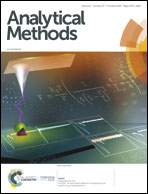Quantum dot-based Baijiu fluorescent identification sensor array jointly verified by multivariate analysis and radial basis function neural network†
Abstract
Simple discrimination between types of Baijiu is important for economic and health-related reasons. For the first time, a quantum dot (QD) array, used in a novel, sensitive and rapid way, was selected for the identification of Baijius. The QDs possess the ability to cross-react with alcohol, aldehydes, ketones, acids, esters, nitrogen compounds and sulfur compounds found in abundance in the Baijiu and exhibit a change, i.e., fluorescence quenching or fluorescence enhancement. Because of this sensitive mechanism, only three array points were needed for clear classification of 22 Baijius, which is an impressive achievement. The CdTe@MPA, CdSe@MPA and Cu:CdS@GSH QDs, were characterized by transmission electron microscopy, and Fourier-transform infrared and X-ray photoelectron spectroscopies. Pattern recognition and neural networks were used in the array and to determine the fitting relationship between the predicted and actual samples. All of the evidence obtained proves that this sensor array is successful. This work may prove to be helpful for the quality control of Chinese liquors on the market and in mass-production.



 Please wait while we load your content...
Please wait while we load your content...